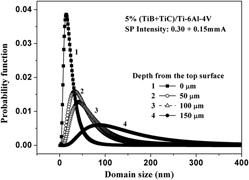Article contents
Surface microstructure characterization on shot peened (TiB + TiC)/Ti–6Al–4V by Rietveld whole pattern fitting method
Published online by Cambridge University Press: 12 July 2016
Abstract

The surface microstructure of shot peened (TiB + TiC)/Ti–6Al–4V is investigated using Rietveld whole pattern fitting method. The domain size and microstrain of them are obtained. By comparing the calculated results between them, it can be found that the microstructure variations of Ti–6Al–4V are more severe than those of (TiB + TiC)/Ti–6Al–4V, which is due to the effect of reinforcements' resistance to the deformation of the surface layer. The distribution of average domain size and microstrain of (TiB + TiC)/Ti–6Al–4V at varying depths are calculated, and the results are discussed in detail. Moreover, the probability distribution of the domain size at different depths is obtained using the lognormal distribution model. Based on the discussion, the results obtained from Rietveld whole pattern fitting method agree with the results calculated using the Voigt method, which reveals that the Rietveld method is an effective method of characterizing the surface microstructure of titanium matrix composites after shot peening treatments.
- Type
- Articles
- Information
- Copyright
- Copyright © Materials Research Society 2016
References
REFERENCES
- 7
- Cited by



